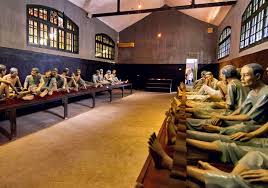Historic Prison Foundation
Kilmainham Gaol Museum represents Ireland's most significant historical prison site, operating from 1796 to 1924. This Victorian-era jail housed ordinary criminals alongside political prisoners, rebels, and independence leaders throughout its operational period. Today, the museum preserves this crucial chapter of Irish history for educational purposes.
Kilmainham Museum Relationship: The relationship between Kilmainham Museum and Irish independence history extends far beyond simple preservation. This institution actively documents Ireland's struggle for freedom through authentic prison experiences, where visitors can walk the same corridors as historical Irish independence leaders.
Victorian Prison Architecture
The prison's distinctive Victorian architecture reflects the penal reform philosophy of the late 18th century. The imposing stone structure features a radial design that allowed for efficient supervision of inmates while maintaining the psychological impact of incarceration. Restoration efforts have preserved these architectural elements to maintain historical authenticity for museum visitors.
The central hall's unique glass roof structure provides natural lighting throughout the facility, creating an atmosphere that visitors find both impressive and sobering. This architectural feature symbolizes the transparency that the museum now represents, contrasting with the building's original restrictive purpose as an active prison.
Prison & Irish Independence Connection
Kilmainham Gaol's connection to Irish independence runs deeper than any other historical site in Ireland. The prison housed leaders of every major Irish rebellion from 1798 to 1916, including Robert Emmet, Charles Stewart Parnell, and the leaders of the 1916 Easter Rising. These relationships are explored through museum exhibitions and guided prison tours.
Visitors discover how the prison became a symbol of British rule in Ireland and ultimately a shrine to Irish independence. The museum preserves the stories of former inmates who contributed to Ireland's political, literary, and social development through carefully curated prison cell reconstructions and authentic historical documentation.





